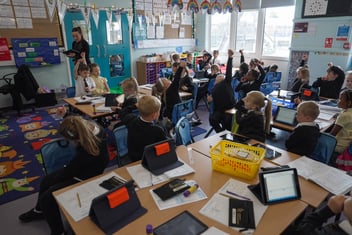Article
Digital Inclusion as a Strategic Imperative
For too long, school digitalisation has been confused with buying gadgets.
Tablets, apps, and platforms have been made to carry hopes that are, at their core, pedagogical and societal. Instead, we need to view digital strategy as a tool for equity and inclusion—never as an end in itself. To succeed, we need a clear WHY and HOW anchored in pedagogical intention.
When Technology Leads—and Why It Often Goes Wrong
Technology should accelerate teaching, not drive it into click-through courses and app catalogues. When initiatives underperform, teachers are often blamed, yet the problem is seldom a teacher’s ability to click; it is the absence of a clear pedagogical why and a systematised how. We have often spent more time showing where to click than discussing what learning actually is and how digital tools can accelerate it.
Research indicates that technology alone does not lead to better learning outcomes; its impact depends on how it is integrated into teaching. In John Hattie’s meta-analyses, for instance, one-to-one laptop programs show relatively low effect sizes, while ICT approaches that enhance effective pedagogical practices achieve stronger results.
The conclusion is simple: start with teaching, not with devices.
Feedback as an Accelerator—a Concrete Example
Feedback remains one of the most powerful levers for improving learning, with an average effect size of around 0.70. As John Hattie notes, “Feedback is one of the most powerful influences on learning and achievement, but this impact can be either positive or negative.” Its potential is significant—but the quality of feedback ultimately determines whether that influence helps or hinders learning.
How digitalisation helps us make feedback better and more inclusive:
- Reach and accessibility: Voice or video feedback makes responses more personal and comprehensible. Students can replay, pause, and annotate—vital for those who struggle with reading or language.
- Living loops: Digital workflows make it easy to run rapid cycles (task → feedback → student response → new feedback) instead of slow “hand-in/hand-back” processes.
- Quality and precision: Structured templates help teachers tie feedback to goals and success criteria, so students can see their progress and the next step.
- Parent partnership: Shared feedback gives parents insight and the ability to support—with translation and accessibility supports when needed.
- Time where it matters: Comments, annotations, voice notes, and short video clips shift time from administration to content and relationship.
This is digitalisation when it works as an accelerator: we start from learning and strengthen what has impact.
From Pedagogical Intention to Practical Inclusion
When digital workflows are built around pedagogical intention, something decisive happens for inclusion: more students can demonstrate their learning in more ways. That lowers barriers—and raises the likelihood of success. This is inclusion in practice.
What does that mean in the classroom?
- More modalities, same standards: Students can present through text, audio, image, and video, but are assessed against clear criteria. This benefits multilingual learners, neurodivergent students, newcomers—and, in truth, everyone who learns differently.
- Visible quality: When What Does Good Look Like is embedded in the task, ideally with student exemplars across formats, expectations become understandable. Guesswork decreases; self-regulation increases.
- Accessible by design: Inclusion is not an exception; it is baked in—with captioning, speech-to-text, structured templates, additional time, and translation as standard features.
- Faster support—earlier: Data from tasks and feedback makes it easier to spot patterns and activate early interventions before problems set in.
- Parents as partners: Clear, translated feedback makes it easier to support at home—beyond the generic “Do you have homework?”
Why does this improve equity?
Because equity doesn’t mean everyone does the same thing; it means everyone has a fair opportunity to show what they know. By opening more pathways to the same goals, we reduce what gets in the way of learning (format, language, anxiety, reading barriers) without lowering expectations.
From Device-Driven to Intentional—Principles That Endure
- Start with the WHY (equity & citizenship): Clarify which gaps you aim to narrow (participation, achievement, attendance, access to support, home–school partnership) and how you will measure them.
- Translate the WHY into the HOW (pedagogical intention): Prioritise high-impact practices—Teacher Clarity, high-quality feedback, clear goals and criteria—and use technology to accelerate precisely these.
- Steer investments with principles: Every device/licence must link to measurable benefit (e.g., percentage of tasks with clear criteria, time to first feedback, proportion of parents engaging with feedback).
- Develop teachers—not clicks: Professional learning should focus on how to give feedback that moves learning, how to make quality visible, and how to design tasks—not on “where to find the button.”
- Scale through PLCs: Use Professional Learning Communities to co-create criteria, share exemplars, moderate judgements, and track impact data. This reduces unsystematic variation and increases fairness.
- Measure what matters: Spend less energy on logins and more on learning-process metrics: time to feedback, student response rates, gains between iterations, and diversity of expression.
Common Pitfalls—and How to Avoid Them
- The app catalogue as the goal: A long tool list rarely creates equity. Choose a few robust tools that serve your pedagogical principles.
- Tech debt in the classroom: Avoid fragmented workflows where a teacher manages four surfaces for one task.
- Blaming teachers: If outcomes lag, return to the why and how—not to more “click training.”
- Vague goals: Without learning intentions and success criteria, feedback becomes fuzzy—with or without technology.
Conclusion: Let Pedagogy Lead—Make Technology Honest
When the WHY and HOW are clear and pedagogical intention leads, technology becomes honest. It accelerates where it should and steps back where it distracts.
The device in a student’s hand becomes powerful only when connected to clear goals, visible quality, and feedback that propels learning.
A digital strategy is no shopping list—it is a system-wide commitment to equity, participation, and active citizenship in a digital world.
Further Reading and Resources
- Hattie, J. A. C. (2009). Visible Learning: A Synthesis of Over 800 Meta-Analyses Relating to Achievement. Routledge.



